Please, Know the Signs—Your Dane’s Life May Depend on It.
Great Danes and Bloat
Woof! I’m a Great Dane, and I need to tell you about something scary that can happen to us big dogs – it’s called bloat.
Us Great Danes have a really high chance of getting bloat in our lives – like 43 out of 100 of us will deal with it! Why? Well, our chests are shaped weirdly. We’re extremely deep but not very wide, much like a slender barrel. The doctors say our chest is shaped 1.4 to 1, which means we’re built like a tall rectangle instead of a lovely square.
Because of our funny shape, our stomachs don’t have much to hold onto inside us. It’s like our stomach is just hanging out loose in there! When bloat happens, our stomach fills up with gas and can flip upside down. Yikes!
If this happens to me or my Great Dane friends, we might act restless and pace around a lot. We’ll try to throw up, but nothing comes out – that’s super scary. We’ll drool more than usual (and trust me, we already drool A LOT), and our bellies will get really big and tight.
This whole thing happens really fast! It starts with just gas, but then our stomach can twist completely around. When that happens, blood can’t flow right, and we need to get to the vet RIGHT NOW for surgery, or we could die.
The good news is that there are ways to help prevent this scary thing from happening to us, gentle giants!
Key Takeaways
My Big Tummy Problems – A Great Dane’s Guide to Bloat
But being this big comes with some problems, especially with my tummy.
You see, my chest is super deep and narrow, kind of like a skinny barrel. This makes my stomach all wobbly inside with no good support. Because of this weird body shape, almost half of us Great Danes can get something called bloat. It’s not fun at all!
When my tummy starts acting up, I do some pretty weird things. I might pace around the house, as if I’m looking for something but can’t find it. I’ll try to throw up, but nothing comes out – just lots of gross retching sounds. I start drooling way more than usual (and trust me, I already drool A LOT). The scariest part is when my belly gets all puffed up like a balloon.
If any of this happens to me, my humans need to rush me to the vet RIGHT NOW! No waiting around!
The terrifying thing is that my stomach can twist around inside me. When that happens, blood can’t flow properly, and I could become sick. That’s why bloat is so dangerous for big dogs like me.
But don’t worry! My humans help keep me safe by doing some smart things. Instead of giving me one giant bowl of food, they give me smaller meals throughout the day. They don’t put my food bowl up high because that makes me gulp air. They also make sure I don’t run around and play hard right before or after I eat. I also have a cool slow-feeding bowl that helps me eat more slowly, rather than wolfing everything down.
If I do get bloat and have to go to the vet, they have ways to help me. They can let the gas out of my tummy and give me special fluids. Sometimes they even have to do surgery to attach my stomach so it won’t twist again. Pretty wild, right?
Being a giant dog is fantastic, but we have to be extra careful about our tummies. My humans watch me closely, and that helps keep me healthy and happy!
Understanding the Anatomy Behind Bloat Risk in Great Danes
Woof! Let me tell you about why Great Danes often experience tummy troubles that can be really scary.
We’re super tall with really deep, skinny chests – kind of like walking around with a pickle jar for a body! This might make us look cool and elegant, but it causes problems for our stomachs.
Our chests are so narrow that when our stomachs get full of food or gas, there’s nowhere for them to go. It’s like trying to blow up a balloon inside a pencil box – things get squished and twisted around in ways they shouldn’t!
The humans with the white coats say our chest width compared to our height is all wrong. They use fancy numbers like 1.4 to 1, but basically, it means we’re built like a telephone pole instead of a fire hydrant. Not very helpful for our bellies!
Here’s the really unfair part – the stretchy bands that hold our stomachs in place are too loose. If you had a hammock with broken ropes, it would flop around everywhere, right? That’s what happens inside us! Our stomachs can flip and twist because those bands aren’t tight enough.
Additionally, the lower part of our stomachs is too small, so food just sits there, much like a traffic jam. Gas builds up and up until – BOOM – we get something called bloat. It’s extremely dangerous and happens to almost half of us, Great Danes, at some point in our lives. Recognizing signs of bloat is crucial for timely intervention.
Pretty unfair if you ask me, but hey, at least we’re still the most awesome dogs ever!
Recognizing Early Warning Signs and Symptoms
So here’s the deal – bloat can go from “hmm, something feels weird” to “HELP ME RIGHT NOW” super fast. Like, we’re talking hours, not days. That’s why you humans need to watch us like hawks and know what to look for.
When bloat first starts sneaking up on me, I might act like I can’t sit still. I’ll pace around the house, as if I’m looking for something, but I can’t remember what. Oh, and here’s the really embarrassing part – I’ll try to throw up or poop, but nothing comes out. It’s like my body is playing a mean joke on me!
You’ll also notice I’m drooling way more than usual (and trust me, that’s saying something for a Great Dane). I’ll be panting like I just chased a hundred squirrels, and I can’t get comfortable no matter how I lie down. It’s like trying to sleep with a rock in your stomach.
Then things get really weird. My belly starts puffing out like I swallowed a basketball, especially behind my ribs. I start looking like a furry barrel with legs! Walking becomes super hard – imagine trying to run with a watermelon tied to your stomach.
My gums turn pale instead of their normal pink color, which means my heart is having trouble doing its job. If it gets really bad, my heart starts racing like a race car, but my pulse feels weak. Sometimes I might even collapse because everything hurts so much.
The scary thing is, if my humans don’t get me to the vet super fast for emergency surgery, this bloat thing can kill me. So please, if you see any of these signs in your Great Dane buddy, don’t wait around – get us to the vet right away! Regular veterinary check-ups can also help monitor our overall health and catch any issues early on.
The Deadly Progression From Simple Bloat to Gastric Volvulus
So picture this – you know how sometimes I gobble down my dinner really fast because it’s SO good? Well, sometimes when we eat too quickly or get really active right after eating, our tummies can get all blown up like a balloon. That’s the first part of this daunting phenomenon known as bloat.
But here’s where it gets really not fun – sometimes our stomach decides to do a flip! Yeah, you heard me right, it literally twists around like someone’s doing a somersault in there. My human says it’s like when you twist a balloon and it gets all knotted up.
When my tummy twists like that, the blood can’t flow right anymore. It’s like when you step on a garden hose and the water stops coming out. Without blood flowing to my stomach, parts of it start getting really sick and hurt.
The worst part? This whole thing happens FAST. Like, one minute I’m feeling okay, and the next minute I could be in big trouble. My heart starts having problems, too, because everything in my body is connected. Preventive measures for hip dysplasia are also essential to keep us Great Danes healthy as we age.
That’s why my humans always watch me carefully after meals and know to call the vet right away if my belly looks too big or I start acting weird. Us Great Danes are tough, but we need our humans to help us stay safe!
Initial Gastric Dilatation Stage
When My Tummy Gets Too Big!
Picture this: I’m having a regular day, and then my belly starts filling up with air, water, or food way more than it should. It’s like trying to blow up a balloon that’s already whole – not good! My stomach can no longer eliminate all this waste in the normal way.
Here’s what makes my tummy blow up like a balloon:
- Gulping Too Much Air – Sometimes I get excited or stressed and swallow tons of air. Or maybe I eat my dinner super fast because it’s SO good!
- My Stomach Gets Lazy – the muscles in my belly stop contracting properly, so food sits there like a rock.
- The Exit Gets Blocked – The door where food leaves my stomach gets stuck shut. That’s a big problem!
- Gross Gas Bubbles – Food that sits too long starts producing stinky gas bubbles, which exacerbate the problem.
The good news is that if humans catch this early, they can still help me feel better without doing anything too scary. However, it’s essential for my humans to understand that certain breeds, such as Great Danes, have a higher risk of food allergies that could complicate my health.
But they need to hurry up because my belly keeps getting bigger and bigger, and that’s when things get really dangerous for us, Great Danes!
Circulatory Shock Development
When My Tummy Gets Really, Really Twisted – A Big Dog’s Guide to Bloat****
When my tummy starts to twist around, bad things start happening inside my body. It’s like when you step on a garden hose – the water can’t flow through anymore! My twisted stomach squishes an important tube called the vena cava that carries blood back to my heart.
Here’s what happens when I get really sick:
My blood gets stuck**** – The blood in my belly area can’t move around like it should. It’s like a traffic jam!
My heart gets confused**** – When my heart doesn’t get enough oxygen, it starts beating all weird and crazy.
My body tries to help – My body squeezes my blood vessels tight to try to keep my blood pressure up, but this makes me feel even worse.
I can’t breathe well**** – My cells don’t get enough oxygen, which makes me really tired and sick.
When this happens, I need help RIGHT NOW! The vet gives me special fluids through a tube in my leg and then does surgery to untwist my stomach. It’s scary, but the vets are really good at fixing us big dogs when we get bloated.
The most important thing is getting help as quickly as possible, because Great Danes are worth saving! Understanding dilated cardiomyopathy (DCM) can also be crucial for our overall health and well-being.
Risk Factors and Triggers Every Owner Should Know
Now, I know I’m adorable when I gobble up my dinner like I haven’t eaten in weeks, but that’s one of the things that can make my tummy go crazy!
Running around right after I eat is another no-no. And those fancy raised food bowls? They might look cool, but they can make things worse for us, Great Danes.
Here’s how you’ll know if I’m in trouble: I’ll start pacing around like I can’t get comfortable, I’ll try to throw up but nothing comes out (super weird and scary!), and my belly will puff up like a balloon.
If you see me doing any of this stuff, please get me to the vet RIGHT NOW! My life might depend on it.
Trust me, catching this early is way better than waiting around. I want to keep playing fetch with you for many more years! Additionally, understanding the risk factors and triggers of bloat in Great Danes is essential for preventing this potentially life-threatening condition.
Feeding and Exercise Triggers
So here’s the deal with eating. My humans used to give me one giant bowl of food, and I’d gobble it up like I hadn’t eaten in weeks. Big mistake! That huge meal made my stomach blow up like a balloon.
Now my humans are way more intelligent – they give me smaller meals spread out during the day. It’s pretty cool because I get excited about food more often!
You know those fancy raised food bowls that look all proper? Well, turns out they’re not so great for us Great Danes. Some smart veterinarians conducted studies and found that elevated bowls increase the likelihood of bloat by up to 110%.
So now I eat from a regular bowl on the floor, and honestly, I don’t mind bending down.
Here’s another thing about us big dogs – we need to calm down around mealtime. My humans have learned that I shouldn’t go crazy with running and jumping right before I eat or for about two hours afterward.
One time, I went nuts chasing squirrels right after dinner, and let me tell you, that wasn’t fun. The bouncing around can cause our stomachs to twist, which is definitely not good.
Oh, and I used to eat like I was in a speed contest! Turns out that’s bad because I was swallowing tons of air with my food.
Now I’ve this cool puzzle bowl that makes me slow down and think while I eat. It’s like a game! Proper training techniques can help reinforce these good habits and ensure my well-being.
Prevention Strategies to Protect Your Great Dane
When I was fixed, the vet performed a procedure called a stomach tack. It sounds scary, but it keeps my belly from flipping around. Most dogs who undergo this procedure never experience tummy troubles again!
My family also ensures I’m calm when I eat (no fighting with my dog daughter over kibble), and they give me smaller pieces of food that are easier to eat. They even watch how much water I drink after running around.
All these rules help keep Great Danes like me safe and healthy. Trust me, following them is way better than a scary trip to the emergency vet!
Questions
At What Age Should I Consider Prophylactic Gastropexy Surgery for My Great Dane?
Woof! Let me tell you about this tummy surgery thing my humans keep talking about. It’s called gastropexy, and it doesn’t sound very safe, but it’s quite beneficial for us, Great Danes.
So here’s the deal – we big dogs have this problem where our stomachs can flip around like a pancake. Ouch! That’s called bloat, and trust me, you don’t want that happening during dinner time. My vet says the best time to get this special surgery is when I’m between 12 to 24 months old. That’s like being a teenager in dog years!
The cool part is they can do it when I get spayed or neutered. It’s like getting two things done at once – kind of like when my humans go to the store for dog food but come back with treats too! The vet says doing both surgeries together makes everything easier, and I only have to wear that annoying cone once.
This surgery staples my stomach to my ribs so it can’t do any crazy flips. Think of it like putting a seatbelt on my tummy! My humans say it will help me live a longer, happier life with lots more belly rubs and treats. And honestly, anything that keeps me healthy enough for more bacon is okay by me!
How Much Does Emergency Bloat Surgery Typically Cost for Great Danes?
When we get regular check-ups at the vet, our humans might pay a few hundred dollars. But if we get bloat and need emergency surgery? Yikes! That bill can be anywhere from $3,000 to $8,000. That’s a lot of kibble money!
Here’s the thing – I can’t tell my human, “Hey, my tummy really hurts!” So they need to watch for warning signs. If my belly looks super swollen like I swallowed a basketball, or if I keep trying to throw up but nothing comes out, or if I can’t sit still and keep pacing around – that’s when they need to rush me to the emergency vet right away!
The faster my human gets me help, the better my chances are of being okay. Plus, catching it early might save some of that scary vet bill, too. Nobody wants their Great Dane to feel awful, and nobody wants to pay $8,000 if they don’t have to!
Can Female Great Danes Get Gastropexy During Their Spay Surgery?
Well, the intelligent humans in white coats figured out they can fix two things at once! When we girls go in to get spayed (that’s when they ensure we don’t have puppies), they can also perform a procedure called gastropexy. It’s a fancy word that means they attach our stomach so it won’t twist up and cause bloat.
The cool thing is, instead of having to go under those sleepy medicines twice, we only have to do it once! That means less stress for us and less worry for our humans. Plus, our humans’ wallets stay a little happier too – and that usually means more treats for us!
Most of us get our spay surgery when we’re somewhere between 18 months and 2 years old, which is perfect timing for the stomach surgery, too. It’s like getting a two-for-one deal, but instead of toys, we’re getting lifesaving procedures!
What’s the Survival Rate for Great Danes After Successful Bloat Surgery?
But here’s some good news that’ll make your tail wag.
When we get that awful tummy twist called bloat, and the smart vet doctors catch it super fast – like within six hours – most of us big goofballs make it through just fine! About 85 to 90 out of every 100 of my Great Dane cousins survive the special tummy surgery called gastropexy. That’s pretty pawsome odds!
The secret is catching it early, just like catching a tennis ball before it bounces away. The faster our humans notice something’s wrong with our bellies, the better chance we have of going back to stealing socks and drooling on the couch.
Time helps us heal after surgery, but the real trick is not letting bloat occur in the first place. That means eating slower (I know, I know – easier said than done when dinner smells THAT good) and not doing zoomies right after meals.
We may be gentle giants, but our tummies need gentle care too!
Are There Specific Insurance Policies That Cover Bloat Treatment for Great Danes?
The good news is that some smart individuals have figured out that we need exceptional help. There are now insurance plans just for dogs like me that cover bloat emergencies. These plans help cover the costs of major surgeries we may need and all the care that follows afterward as we recover.
My human mom says that many pet insurance companies now offer special deals for large breeds, such as Great Danes. They know we’re more likely to have tummy problems, so they made plans just for us! It’s like having a safety net in case my stomach decides to do backflips.
Final Thoughts
So here’s the deal – almost half of us Great Danes (that’s like 42 out of every 100 dogs like me) might get bloat sometime in our lives. That’s way more than other dog breeds! Our stomachs can get twisted up and filled with gas, which is super dangerous.
Now, I can’t change the fact that I’m a Great Dane – trust me, I’ve tried shrinking myself, but it doesn’t work! But my humans can help keep me safe. They can get me a special surgery called gastropexy that keeps my stomach in place. They also feed me smaller meals instead of one large bowl, and they watch me closely for warning signs.
Speaking of warning signs, if I start acting weird, like trying to throw up but nothing comes out, or if my belly looks bigger than usual, my humans need to get me to the vet as quickly as possible. The quicker they act, the better my chances of being okay.
Being a giant dog is fantastic, but it comes with some extra responsibilities. It’s a good thing I have humans who love me enough to keep me safe!
References
- https://www.petmd.com/dog/conditions/digestive/bloat-in-dogs
- https://vcahospitals.com/know-your-pet/bloat-gastric-dilatation-and-volvulus-in-dogs
- https://www.danegoodblog.com/signs-of-bloat-in-great-danes/
- https://www.ufaw.org.uk/dogs/great-dane-gastric-dilatation-volvulus-syndrome
- https://animalemergencyhospital.net/dog-breeds-with-high-risk-of-bloat/
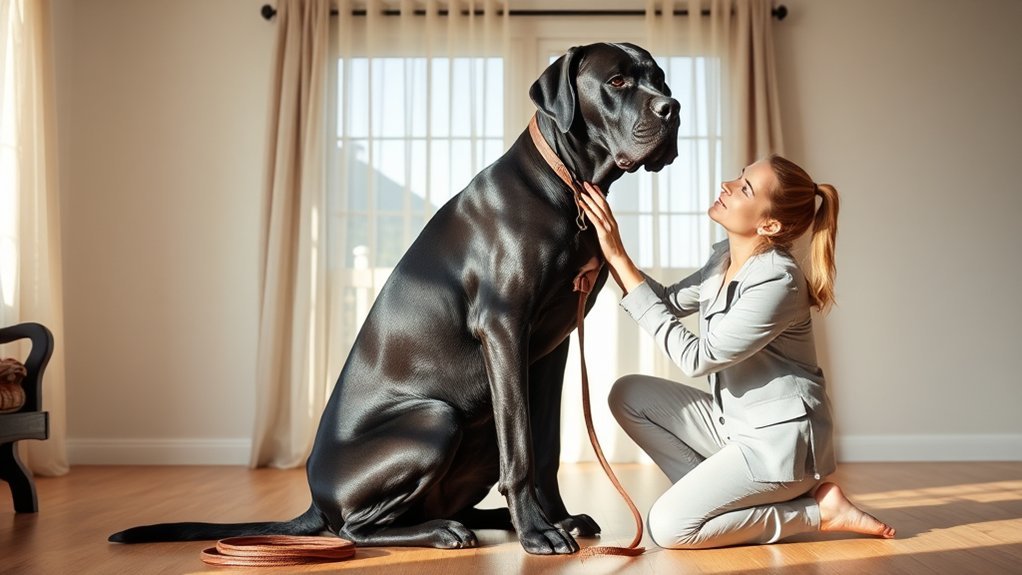
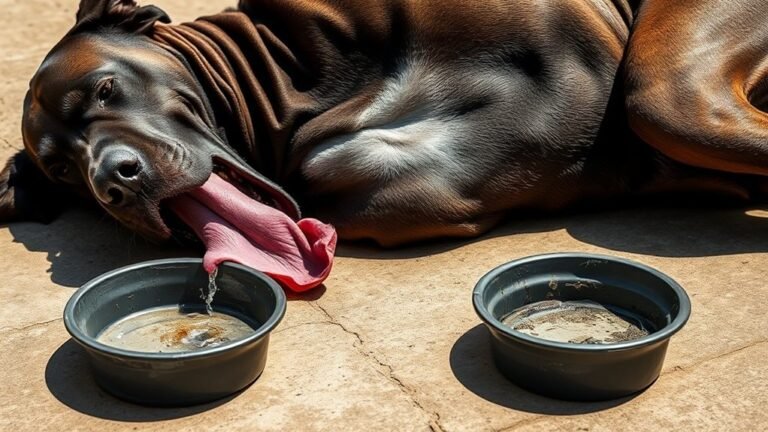
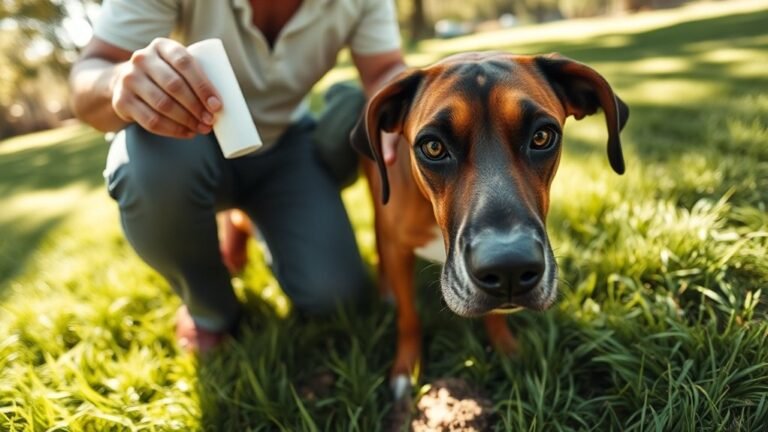
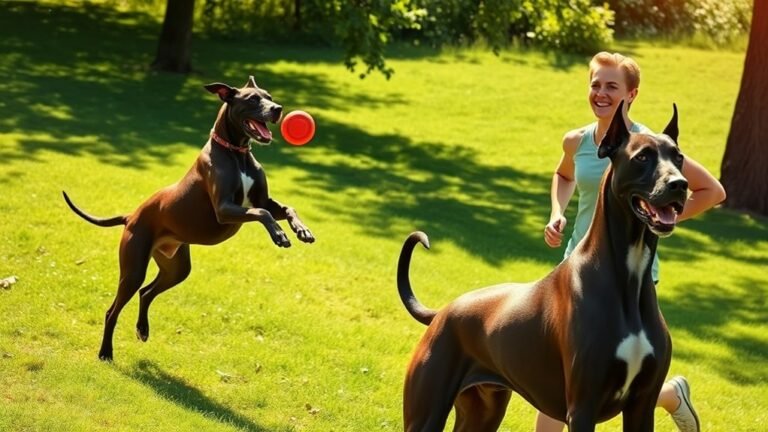
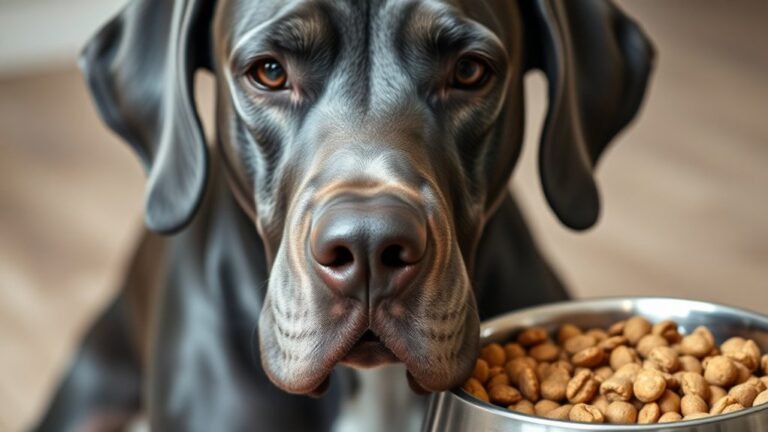

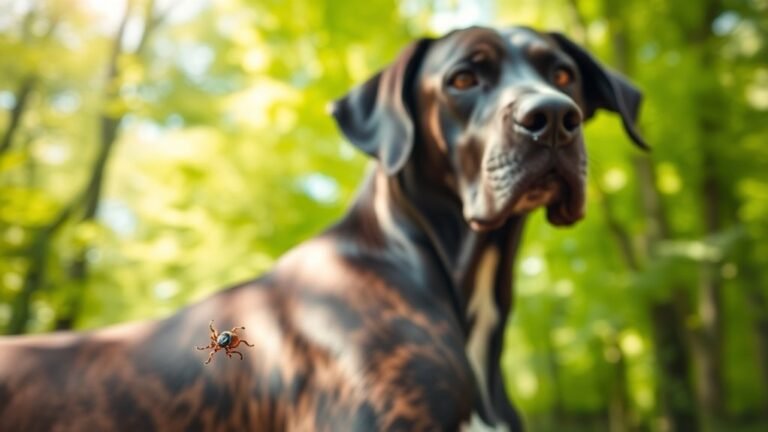
5 Comments